At least once in our lives, we have all come across strange or unusual plants. In general, acquaintance with such representatives of the plant world begins in childhood, when we see a cactus and do not understand what it is. We are told that it is a plant. But after all, there are no leaves, no stem, nothing that the child considers to belong to a normal plant. This article looks at even stranger plants that look more like they came from another planet.
This desert dwarf tree can live up to 2000 years. The trunk of the plant is short and stump-like, a pair of leaves extends from it in two directions. As they grow, they are torn into longitudinal ribbons, and their tips dry out. The age of these giant leaves is equal to the age of the tree itself. Despite the dying off of the tips, the leaves from the base are constantly growing at a rate of 8-15 cm per year. Sometimes the length of the leaves can reach 8 meters, and their width - 1.8 meters. Velvichia grows in the south of Angola, in a rocky desert. Usually a plant can be found no more than a hundred kilometers from the coast - it vitally needs fogs that provide moisture. The plant itself is extremely ascetic, the leaves twisted in a turban help the precious water to get to the roots.


This genus, like Rafflesia, is famous for its aroma of decaying flesh. The flower has a terrible smell, few people can stand next to it without special protective equipment. Most representatives of the genus have a huge flower, so, in some plants of the species Amorphophallus titanum, it can reach a height of 2.5 meters with a diameter of 1.5 meters. This, by the way, is one of the largest inflorescences in the world. Amorphophallus grows in the tropics and subtropics, in flat places. Interestingly, in many countries of the East, plant tubers are widely used in cooking. So, in China, Amorphophallus has been cultivated for 1500 years as a cholesterol-lowering dietary product. In Japanese cuisine, tubers are used in soups and stews.
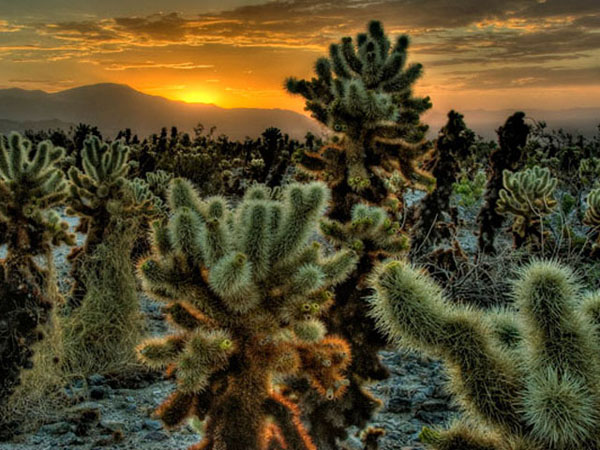
This is one of the most amazing species from the genus Opuntia of the Cactus family. Usually in the area where this species grows, you can see a large number of fluffy two-meter cacti. When the sun goes down, it looks just fantastic. A person who is here may get the impression that he visited another planet as part of a space expedition, while unknown life forms are around. Prickly pear is valuable for its fruits, it is also used as a hedge and as animal feed.

This is another one of the amazing plants of the Cactus family. The most amazing thing about it is its size. Growing in Arizona, Mexico and California, carnegia can reach a height of as much as 14 meters, while its diameter is up to 3 meters. Individual cacti live up to a century and a half.
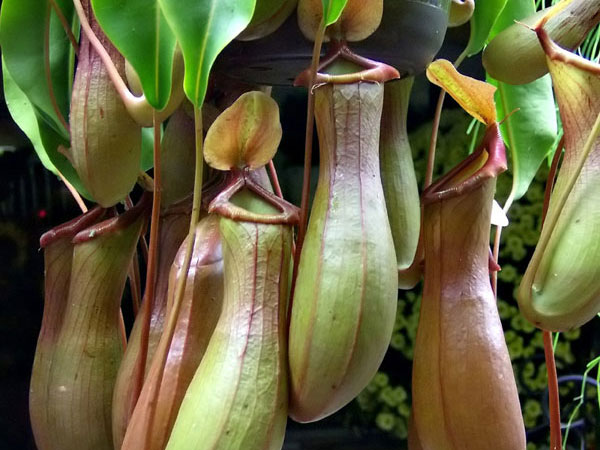
Almost all plants of this genus can be safely called predators, as they receive the necessary nutrients by digesting the caught insects. Most species grow in the tropics of Asia, mainly on the island of Kalimantan. The plant's leaves are shaped like water lilies. To attract insects to inner surface the jug has special cells that secrete alluring nectar, there are also hair cells that serve to hold the caught victim. The trap is very sophisticated - the surface on the neck of the jug is very slippery, so the victims slide down, where they fall into the water and drown. Some species contain up to 2 liters of water in a water lily. Enzymes are produced by the plant to process insects, sometimes even mice, rats and small birds fall into the trap.

This killer plant is even more amazing, as it takes much more active action to capture prey. The leaves of the plant are peculiar jaws that slam shut, captivating not only insects, but even snails and frogs. Digestion of food takes about 10 days, on average, during the life of a plant, 3 insects fall into its jaws. The flycatcher grows in the temperate zone, on the Atlantic coast of the United States.
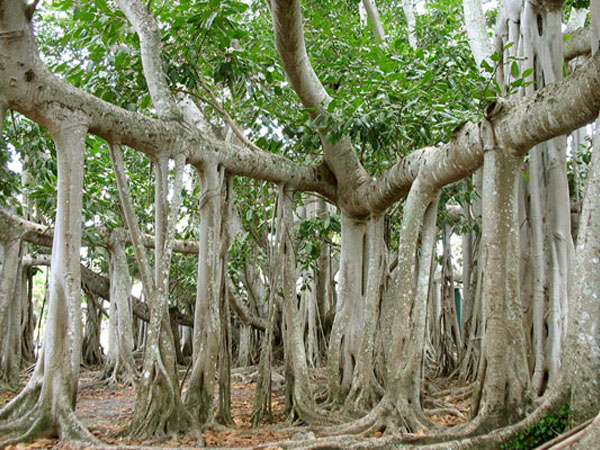
Many in the photographs see not one plant, but their whole forest, although this is erroneous. The fact is that this ficus is characterized by a special form of life - a banyan tree. Ficus forms powerful branches, from which shoots or "aerial" roots grow down. Most of them dry up before reaching the ground, while the more successful ones take root, forming new columns-trunks. This plant grows in India, Sri Lanka and Bangladesh. As a result, the tree can grow so much that it will take several hectares.
![]()
This California tree is known for being the tallest tree on Earth. Compared to it, our temperate forests are just grass. This is not surprising, because the age of some reaches 3500 years, and the height exceeds 110 meters. The diameter of the largest sequoia was more than 11 meters. Some of the most remarkable trees even have their own names, once houses were hollowed out in the trunks of such trees and tunnels for roads were cut through. When a strong wind blows, being in a forest with sequoias can become unpleasant - not everyone can withstand the swaying of gigantic trunks and the noisy rattle from them.

This plant grows in the Peruvian and Bolivian Alps. It is known for having the largest inflorescence, which reaches a height of 12 meters and a diameter of up to 2.5 meters. It consists of 10 thousand simple flowers. Puya blooms only once in a lifetime, reaching its 150th anniversary, after which the plant dies.
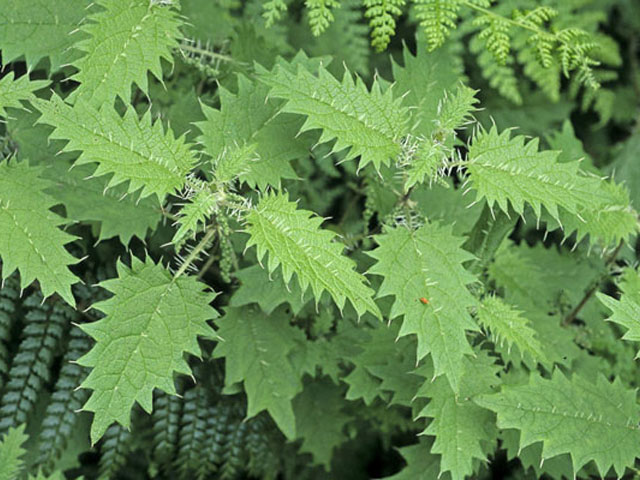
Ongaonga (Urtica ferox) or New Zealand nettle tree. This plant has a tree-like trunk, and its spines are unusually dangerous. They contain formic acid and histamine. Nettle tree can reach 5 meters in height, the slightest touch to it leads to the appearance of a painful burn. There are known cases of death from the poison of a tree of horses, dogs and at least one person. Interestingly, the plant is the main food of the Red Admiral butterfly larvae.
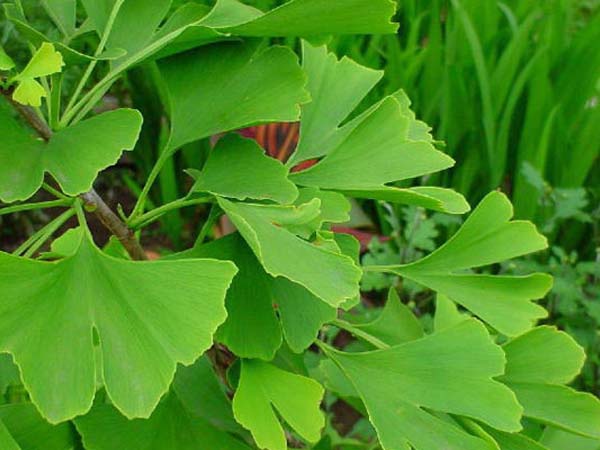
A relic plant that grows in China. The species originated 16 million years ago, so this plant is the oldest of those that grow on the planet. Another name for ginkgo is "silver apricot". In shape, these are trees with falling leaves, the height of plants can reach 30 meters. Some trees can live up to 2500 years. Medicines are prepared from ginkgo leaves. AT recent times it has become fashionable to use compounds from the leaves, although the medical effect of them is far from obvious.
Popular myths.

Christianity is one of the three world religions that arose in the 1st century AD. in Palestine, in the center of which is the image of the God-man - Jesus Christ ....

Alexander Nikolaevich Radishchev - Russian writer, philosopher, poet, director of the St. Petersburg customs and member of the Commission for drafting laws....
Our planet is home to 300,000 plants, so it's no surprise that sometimes you can find truly bizarre and unique plants.
We all know roses, tulips and other commonly grown flowers, but did you know that there are rare orchids that look like monkey faces, dancing girls or flying ducks? Have you heard of a plant that eats mice? What about plants that smell like dead flesh or feces? In fact, the plant kingdom is very diverse and exciting with thousands of stunning plant species that you have most likely not even heard of.
To show you how diverse and unique flora of our planet can be, in this list we will tell you about the most bizarre and unique plants in the world. From oddly shaped orchids and "living rocks" to snapdragons, Darth Vader's flower and vicious carnivorous plants capable of digesting small animals, here are some of the strangest and most unusual plants on the planet.
25. Prayer Abrus (Crab´s eye)
Abrus prayer is a slender, climbing perennial plant that wraps around trees, bushes and hedges. This plant is endemic to almost all of the tropics and is best known for its seeds, which are used as beads as well as in percussion instruments. It is worth remembering that these seeds are poisonous due to the fact that they contain abrin (Abrin).
24. Lithops from the Karas Mountains (Lithops karasmontana) 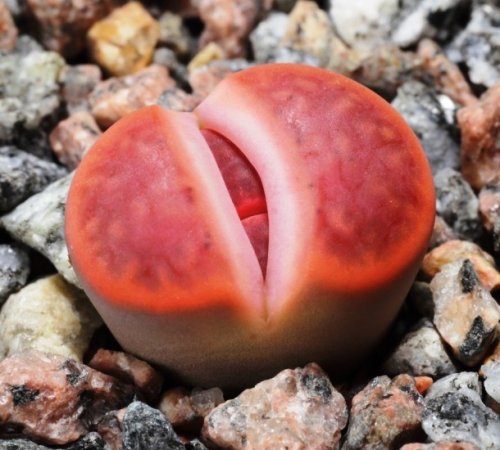
'Lithops karasmontana' (which translates as living rock from the Karas Mountains) is a species of flowering plant in the Aizoaceae family, endemic to Namibia and southern Africa. This unique looking plant escapes herbivore attacks by mimicking rock formations. When these plants are not in bloom, they are almost indistinguishable from rocks.
23. Radiant leader (White Egret flower)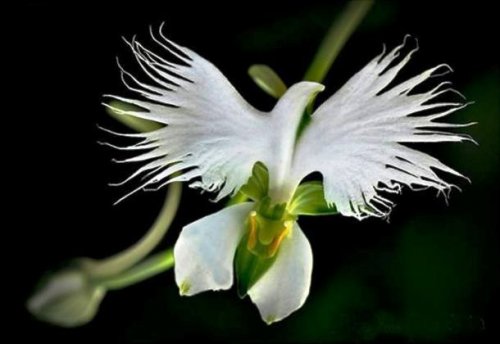
The radiant leader is a species of orchid endemic to China, Japan, Korea and Russia. The flower resembles a white dove, but should not be confused with the white fringed orchid Platanthera praeclara, which is a North American species.
22. Rafflesia Arnold (Corpse flower)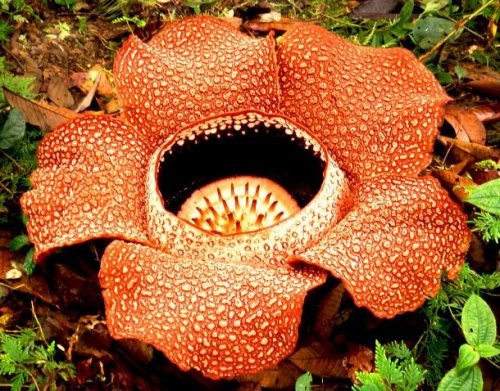
Rafflesia Arnold, endemic to the rainforests of Sumatra and Borneo, is notable for being the largest single flower on Earth (1 meter in diameter). The scientific name of this plant is Rafflesia arnoldii. The flower exudes a very strong stench, reminiscent of the smell of decaying flesh, due to which it is also called a corpse flower.
21. Orchid "Dracula benedictii"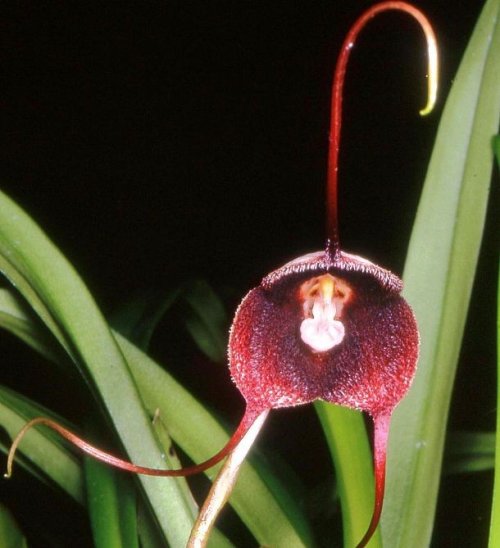
'Dracula benedictii' is a rare species of orchid found in the central and western Cordilleras of Colombia. This monkey face orchid was named after Benedict Roezl, the famous bohemian collector who discovered it.
20. "Nepenthes distillatoria"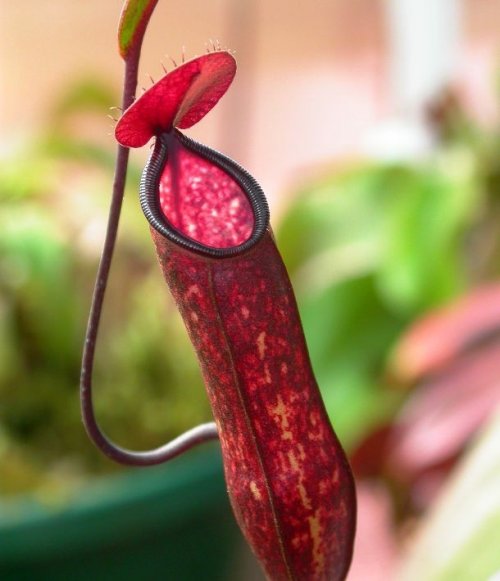
A tropical carnivorous plant of the Nepenthes genus called 'Nepenthes distillatoria', found in Sri Lanka, is famous for its leaves that have turned into deep traps. They serve as a sort of mechanism to trap prey into a deep cavity filled with digestive fluid. The diet of the plant usually consists of insects, however, in some cases, frogs and even mice have been found in them.
19. Psychotria or Lips of a prostitute (Hooker's lips)![]()
The Hooker's Lip plant, scientifically known as psychotria (Psychotria Elata), is a species of flowering plants from the madder family (Rubiaceae). This plant, endemic to parts of Central and South America, appears to have evolved into its current form in order to attract pollinators, including hummingbirds and butterflies.
18. Euphorbia fat (Baseball plant)
Euphorbia obese, endemic to South Africa (particularly the Cape Province), is a subtropical succulent notable for its bizarre baseball-like shape. In the wild, the plant is endangered due to over-harvesting and poaching, as well as its slow growth.
17. Orchid-ballerina (Ballerina orchid)
The ballerina orchid is a small, inconspicuous earthen orchid with long narrow flower petals that grows both singly and in groups. This type of orchid can only be found in a very small region in southwestern Australia. The ballerina orchid is on the verge of extinction. Despite the fact that this plant can live for many years, it blooms only for two weeks.
15. Kirkazon Salvadoran or flower Darth Vader (Darth Vader flower)
The Darth Vader flower, scientifically known as "Aristolochia Salvadorensis", is a species of Aristolochia, a numerous plant genus with over 500 species. The plant, reaching 30 centimeters in height, mainly grows as an annual plant. This means that it only exists for one season.
14. Fern rachis (Fiddlehead fern)
Fern rachis or fern snails are rolled young fern shoots that are harvested for use as a vegetable. Fern rachis have antioxidant activity, are high in iron and fiber, and are a source of omega-3 and omega-6 fatty acids.
13. Tacca Chantrier (Black bat flower) 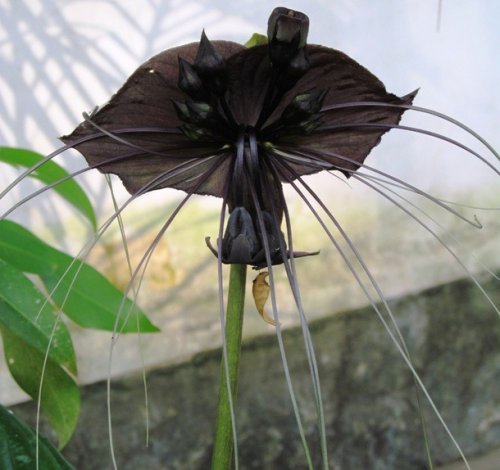
The Tacca Chantrier plant, endemic to tropical regions of Southeast Asia, including Thailand, Malaysia and southern China, is a species of flowering plant in the Dioscoreaceae family. This plant growing in the undergrowth is especially notable for its unusual black flowers, which are shaped like a bat.
12. "Ceropegia haygarthii"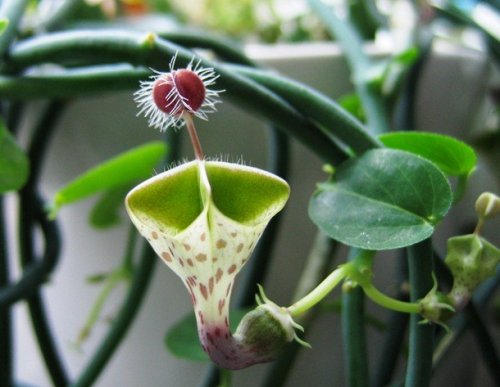
'Ceropegia haygarthii' is a sturdy climbing vine with small, very unusually shaped cream and reddish-brown flowers. The plant is one of the species of the kutrovye family and grows in Angola, South Africa and Mozambique.
11. Dancing Girls Orchid (Impatiens Bequaertii)
What looks like two dancing girls are actually very rare flowers of the species 'Impatiens Bequaertii', one of the 1000 species of the genus Impatiens, a flowering plant that is widespread throughout the northern hemisphere and the tropics.
10. Orchid "Babies in Diapers" (Swaddled babies orchid)
The 'Babies in Diapers' orchid, officially known as 'Anguola uniflora', is a small Anguloa native to South America, where it grows at altitudes between 1,400 and 2,500 meters above sea level. The orchid is famous for its large flowers, reminiscent of babies in diapers, which exude a rich aroma.
9. Snapdragon (Skull flower)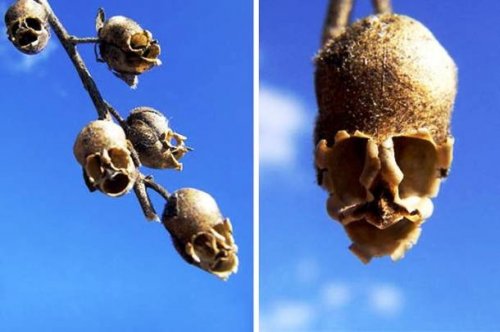
Snapdragon (Antirrhinum) is a climbing plant native to the rocky regions of Europe, the United States and North Africa. Once upon a time, people were afraid of it and believed that it had mystical powers due to the similarity of its dried flowers with skulls.
8. Phalaenopsis (Moth orchid)![]()
Phalaenopsis, first discovered on a small island off the east coast of New Guinea in 1653, has a uniform texture that makes it easy to identify. Currently, this type of orchid can be found in the eastern and southeastern regions of Asia.
7. Single-flowered calceolaria (Darwin's slipper)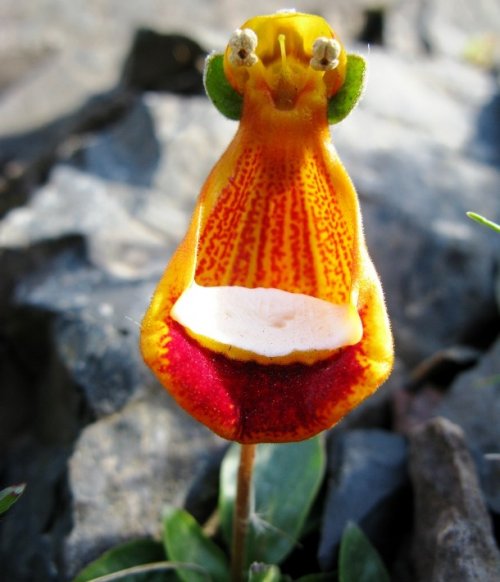
Calceolaria uniflora, scientifically known as "Calceolaria Uniflora" is a perennial plant of the genus Calceolaria (Calceolaria) with yellow, white and red-brown flowers. Calceolaria is a mountain plant, reaching a height of only 10 centimeters. This plant is endemic to the Tierra del Fuego archipelago, located in the south of South America.
6. Nepenthes Rajah (Nepenthes rajah)
Nepenthes Raja, endemic to parts of Borneo, is an insectivorous plant from the Nepentaceae family. It grows exclusively on serpentine substrates, particularly in areas where groundwater seeps through with loose and constantly moist soil. Due to the very limited and localized area of growth, this plant is classified as an endangered species.
5. Strongylodon large-handed (Jade vine)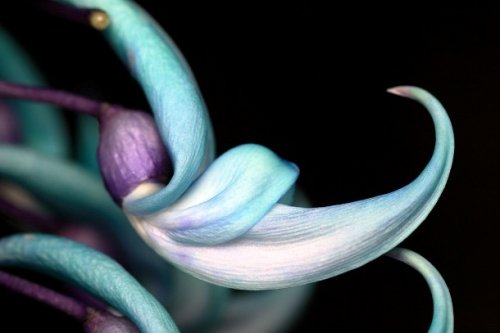
Strongylodon largecarpus, also known as Emerald Strongylodon, is a species of perennial leguminous arboreal Strongylodon endemic to the rainforests of the Philippines. Being a close relative of common legumes, this plant has very long stems that reach 18 meters in length.
4. Double leaf (Skeleton flower)
Bifolia, scientifically known as "Diphylleia grayi", is a species of the barberry family (Berberidaceae). It is a small plant notable for its white petals that become when it rains. When dry, they turn white again.
3. Orchid "Flying Duck" (Flying duck orchid) 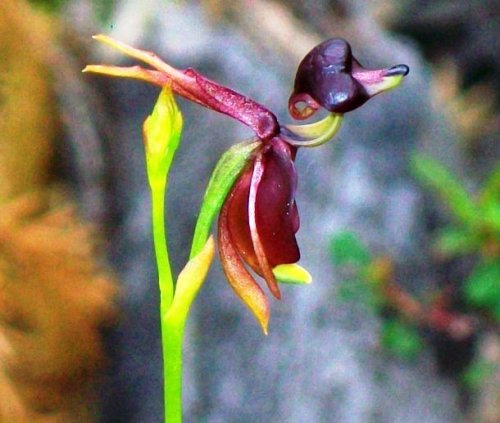
The Flying Duck Orchid is a small orchid native to eastern and southern Australia. This terrestrial plant produces a marvelous flower resembling a duck in flight. The flower attracts insects such as male sawflies, which pollinate the flower in a process known as pseudocopulation.
2. Passion flower meat red (Maypop)
Meat red passion flower, also known as incarnate passionflower, red white passionflower, corporal passionflower or apricot liana is a fast growing perennial vine with climbing stems. The meat red passionflower is a member of the passionflower genus and produces large compound flowers with prominent stamens. This is one of the hardiest species of passionflower and is widely distributed in the southern United States.
1. Starfish flower
The starfish flower is one of the so-called corpse flowers. It is a strange looking plant that exudes a disgusting smell of rotting flesh. Despite the stench, this flower is very popular with gardeners and collectors who appreciate its unusual appearance and bright color.
Welwitschia (Welwitschia mirabilis). Without a doubt, Velvichia can be called one of the strangest plants on our planet. The thing is that on the surface this plant is represented by only two leaves. At the same time, IT lives from 400 to one and a half thousand years. Two leaves of velvichia grow and grow until the whole mass looks like something incomprehensible. The length of each sheet is approximately 2-4 meters (sometimes up to eight meters).
Welwitschia grows in Namibia, and the main source of moisture for it is fog - and only where there are fogs is Welwitschia found. By the way, without rain, she can live up to five years, only due to atmospheric moisture. It is said that the shoots (sporangia) of velvichia are quite tasty when baked in a fire.
In general, velvichia is a very strange plant that is unlike any other.
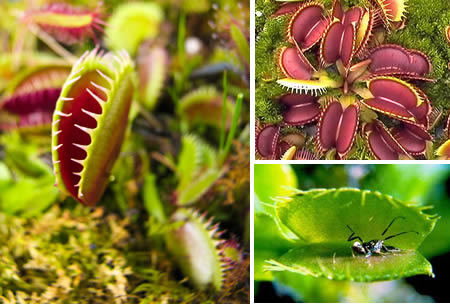
2. Venus flytrap
This plant has long been the main character of various cartoons about insects. The fact is that this is an insectivorous plant that obtains food with the help of special traps. As soon as a fly or other insect sits on an attractively smelling and shiny trap, it slams shut in less than a second (!). Where else are these plants?
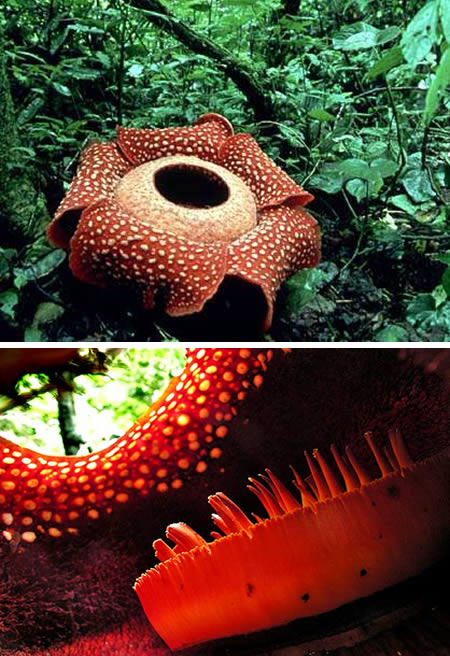
3. Rafflesia arnoldi
This plant consists of a single part - a flower. Without any doubt, rafflesia is the largest flower in the world, which sometimes reaches 2 meters in diameter. But you won’t be able to admire this flower - not only is it not very beautiful, it also emits an unpleasant smell of rotting meat.
What for? Of course, to attract more flies and other carrion lovers. The fly flies in, falls out in the pollen, and flies home until it meets another such flower. This is how cross-pollination occurs. Spread rafflesia, oddly enough, elephants. Rafflesia bears fruit in large balls of seeds, and elephants, passing by, crush these balls, spreading rafflesia on their feet. As a result, this flower spreads along the elephant trails.
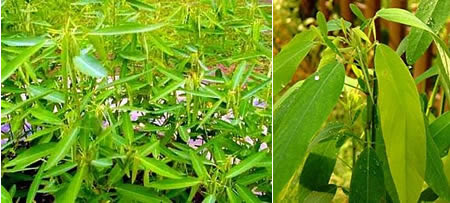
4. Desmodium gyrans: everyone dances!
Desmodium gyrans was described by Darwin. Modern botanists call it either Desmodium gyrans or, more correctly, Codariocalyx Motorius. This plant surprises everyone with the movement of its leaves - the plant seems to be dancing, especially if there is a lot of sun.
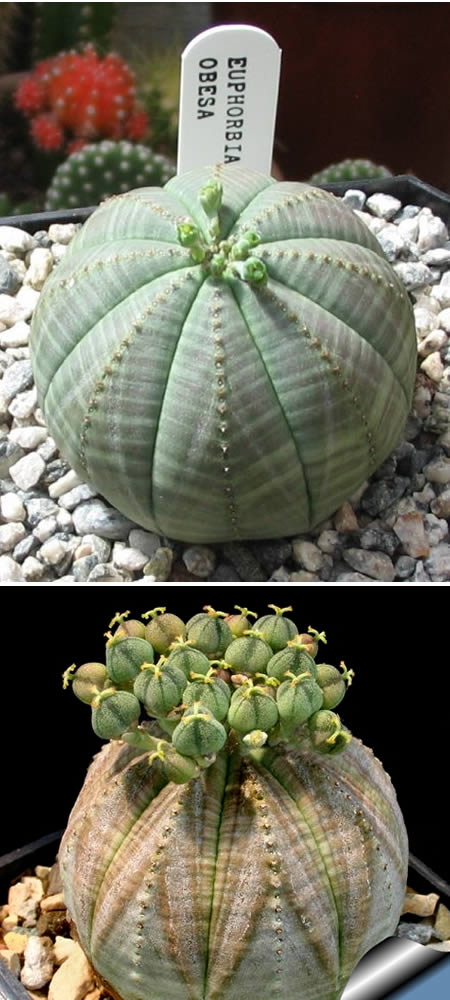
5. Euphorbia obesa: baseball plant
This plant is native to South Africa and has become famous for its original form. Euphorbia obesa is very similar to a ball (not necessarily a baseball, of course). This plant is also known for its rarity - the fact is that Euphorbia obesa is endemic, that is, it grows strictly in a certain region, not found anywhere else.
Now many private collectors - florists, as well as botanical gardens, have begun to cultivate this species, so that the threat of extinction is at least partially eliminated.
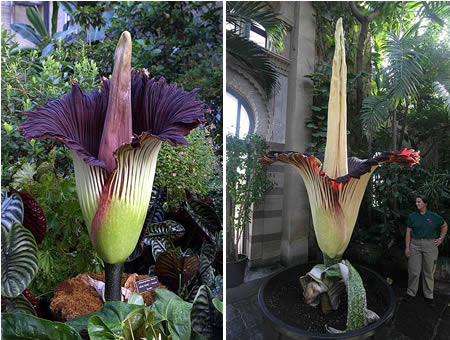
6. Amorphophallus titanum: corpse flower
A giant plant whose flowers are the second largest in the world (after rafflesia). The smell of this plant is simply disgusting - it is usually compared with the smell of rotten eggs, spoiled fish or meat. It is clear that this is not just so, but to attract insects that are attracted to corpses, but in this case, insects serve as pollinators.
Surprisingly, the plant lives up to 40 years, and blooms only a couple of times. So we can assume that you are lucky if you see Amorphophallus giant blooming.
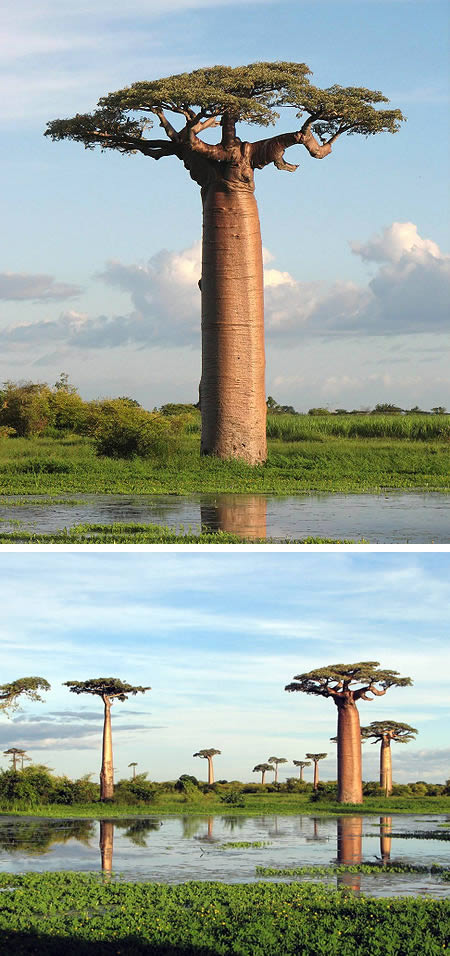
7. Baobab
Well, we all know about this tree, but still, let's admire it again. In total, there are about eight species of baobabs, and they are found in Madagascar (yes, remember this cartoon? There were baobabs), Africa and Australia. An adult tree can store up to 300 liters of water, they live up to 500 years, which is a lot for a tree.

8. dragon tree
This plant is found in the Socotra archipelago (territory of Yemen). It looks rather strange, and the sap of the tree is red, which leads to such a name for the species. Medieval scientists, who first discovered the dragon tree, considered it a half-animal half-plant, and the red juice was real blood. This juice has long been used as a medicine for many diseases (probably still used today).

9. Mimosa púdica: the shy plant
Mimosa púdica is a very sensitive plant. The fact is that if you touch a mimosa, or if it is caught by a gust of wind, the mimosa immediately “pretends” to be dead, all the leaves fall to the ground, and the plant seems to have withered. Within a few minutes, the mimosa comes to its senses in order to "wither" again as soon as someone or something touches it. Found in South and Central America.
duckbill orchid
A small herbaceous plant living in Australia has learned to make its flowers look like small, 2 centimeters long ducks.
Pollia condensata: not yet nano, but already high technology
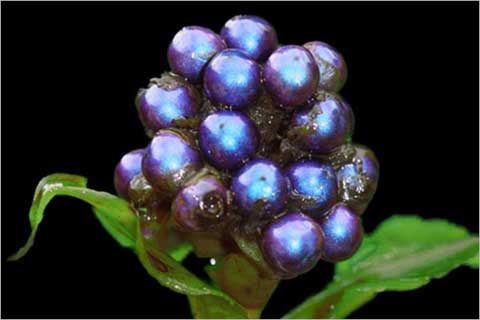
Pollia condensata lives in the deep forests of Africa - a small, unremarkable plant. Its fruits are notable: their blue color is 10 times more intense than any color created with pigment. But that's not all - the color does not fade with time, does not collapse from the absorption of light. The bright blue berries of this plant do not fade for many years and even decades after picking.
Chinese mushroom"immortality" Lingzhi: two millennia at the top of the ranking
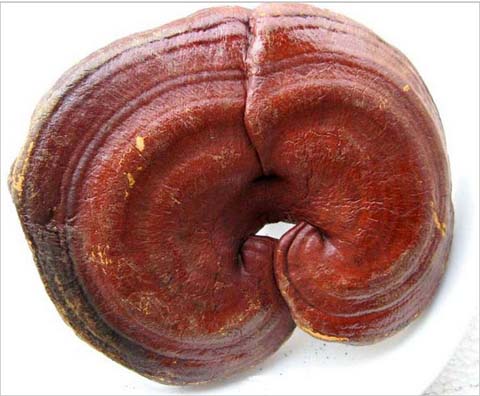
Among the mushrooms that regularly fall into the baskets of avid lovers of "silent hunting", there are many that help doctors in the fight against various human ailments. But, none of them can even closely compare with the unique mushroom known in China under the name lingzhi (Ganoderma lusidum), which has been on the first line in the list of unique medicinal plants for more than two thousand years. Lingzhi is an incredibly capricious mushroom. In the wild, it has always been extremely difficult to find it, because it germinates from tough, rough spores only under certain conditions. This tree fungus lives exclusively on wild plums. But not everyone likes him. The famous ancient physician Ibn Sina claimed that lingzhi takes root only on 10 plums out of 10,000 that were affected by spores. His medicinal properties were incredibly valued, and the complexity of the search turned the successful collector of medicinal plants, who attacked the lingzhi mycelium only once, into a real rich man.
Rambutan: Paradise is closer than you think

The inhabitants of Asia claim that if you eat at least one fruit of this tree, then life will become noticeably longer. The local population knows for sure that only rambutan is able to acquaint ordinary mortals with the taste of the food of the gods - ambrosia, and the garden of its trees is a place where every righteous person can get acquainted with the place of his future life- paradise. The evergreen rambutan grows up to 6 meters. Its flat, small, petalless flowers are grouped in erect panicles. There is nothing heavenly in the discreet appearance of this native of the Malay Archipelago in Southeast Asia, but during the flowering period, the fragrant sweet nectar of unprepossessing inflorescences exudes such an amazing smell that a myriad crowd of suffering people gather around to break into paradise. These are mainly butterflies, flies and other insects - they guarantee timely pollination.
Dracunculus: a common Mediterranean miracle
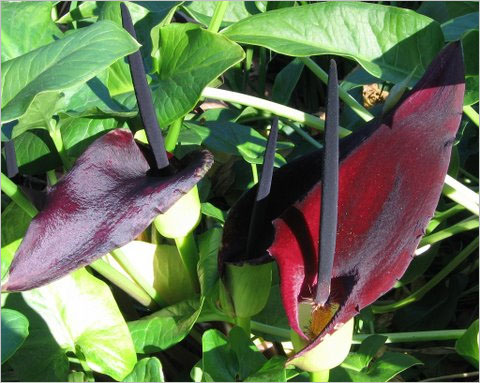
In the northern latitudes, climatic conditions leave very few opportunities for experiment, but in warm climes fantasy of nature is where to turn around. What kind of creatures do not come out of her workshop! Particularly impressive are the plants, whose size simply staggers the northerners. These include the inhabitant of the Mediterranean coast with the intriguing name Dracunculus vulgaris. It all begins in early spring, when a pedicel appears from a huge bulb, quickly reaching a height of about a meter with two dissected forked leaves. By the end of May, a flower opens on it, the length of which reaches 50 cm.
Parachute flower: the forerunner of the airborne paratroopers
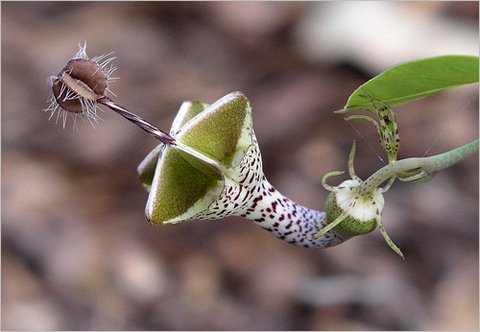
Carl Linnaeus, describing this graceful plant in 1753, wanted to give it the name "parachute flower". But the parachute had not yet been invented, so the scientist decided not to get ahead of events, and christened this representative of the African flora simply and without any frills - Ceropegia Woodii. And only in the 20th century, when parachutes ceased to be a curiosity, justice prevailed. This herbaceous evergreen belongs to succulents. It is distinguished by the presence of numerous intertwined thin, thread-like light green creeping shoots.
Rainbow Eucalyptus: abstract paintings in Australian forests
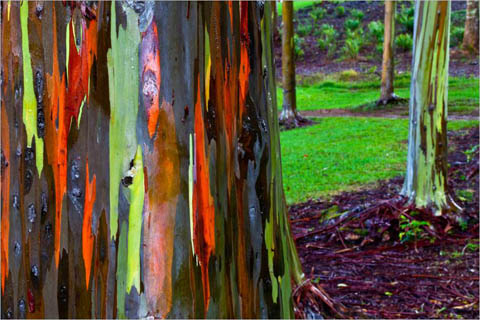
At the mention of eucalyptus, even a not very advanced connoisseur of geography will immediately imagine distant Australia. And a funny, like a teddy bear animal - a koala, with an appetite gobbles up green juicy leaves. But this tree, known for its outstanding growth, has a relative whose favorite pastime is to dress up beautifully. A relative is known under the name rainbow eucalyptus. In this unusual plant, the bark is painted in all the colors of the rainbow, which makes it look like a native beauty dressed in colorful festive dresses. The multi-colored tree comes from the Philippine island of Mindanao.
Mutinus canine. strange appearance

He leads a secluded life, tries to hide, as rarely as possible to catch anyone's eye. Most often hides in secluded places in the forest. It is understandable. It is difficult to imagine a different behavior of someone whose appearance is surprisingly similar to a certain intimate part of the body of a small dog. Of course, the appearance is not chosen, but few people like it when they constantly point the finger at it. A mushroom with such an unusual appearance has a name that was probably inspired by its appearance: Mutinus canine.
Amazing "living stones" lithops

Lithops- These are single-stemmed plants that have two clearly marked fleshy leaves, unusually similar to sandstone processed by wind and rain. The leaves sit on a very short stalk, smoothly turning into a taproot that goes deep into the ground in search of moisture. In autumn, yellow, pink or white flowers hatch between the leaves, resembling bright brushes, comparable in size to stone-like leaves.
Zhiryanka is a terrible swamp predator that hunts even during the day

Plant zhiryanka nothing outwardly remarkable. Its green leaves form a rosette. But woe to the insect that weakened its vigilance and wished to rest on the smooth surface of beautifully gleaming leaves!
Aldrovanda vesicularis

A plant with a beautiful name Aldrovanda vesicularis loves to settle in shallow, stagnant waters of ponds and lakes, rich in decaying bottom sediments. It loves warm summers and clean nature. You can meet Aldrovanda everywhere except Antarctica and the far north.
Govenia sweet: lollipops on the branches

In the common people, it is known as a candy tree, and scientists gave it a name. Govenia sweet or Hovenia dulcis.
Doll's Eye: alien plant

white crow, as a rule, it grows in the mountains of North America (in the east).
Porcupine tomato - an amazing weed with thorns

Porcupine tomato, which the British call Porcupine Tomato, lives in Madagascar
Mimosa bashful - a shy plant
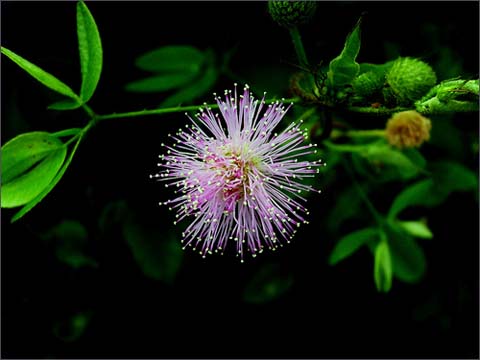
This type of mimosa received its unusual name for an unusual feature: if you touch the plant, then it, as if embarrassed and feeling awkward from the touch, folds its palmate-pinnate leaves and lowers the petiole. After a short time, if there are no new irritants, the leaves unfold again, returning the plant to its original form. Such an interesting ability is harmful: the touchy mimosa cannot hide its leaves for a long time; with prolonged irritation, it dies from energy exhaustion. The leaves also fold at night.
Cedar-Apple Rust Fungus: even seasoned mushroom pickers are shocked

This monster is called cedar-apple rotting mushroom". However, mushroom pickers do not pay attention to Cedar-Apple Rust Fungus(this is his English pseudonym) as their interests are not affected.
Mysterious finds in China: the fruits of the runic flower

In nature, many plants and animals have learned to disguise themselves as other species for safety reasons. But what is found in the soil in different provinces of China defies reasonable explanation. Many are increasingly inclined to think about extraterrestrial origin or involvement in the finds of unknown civilizations.
The frightening forms of the fruits of the "Chinese runic flower" are surprisingly similar to small potato men.
Gidnora: a little-known African predator
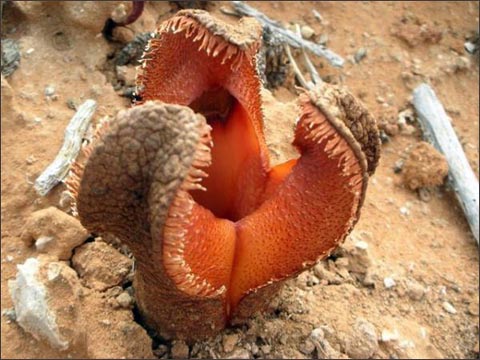
Its homeland is the eastern regions of Africa. It is also common in Madagascar. Although common - not entirely true. It's just so hard to find him. Only a few travelers, while walking through the African deserts of the southern and eastern outskirts of the continent, had a chance to see this monster.
To ragged tooth (Hydnellum peckii): pretty killer mushroom
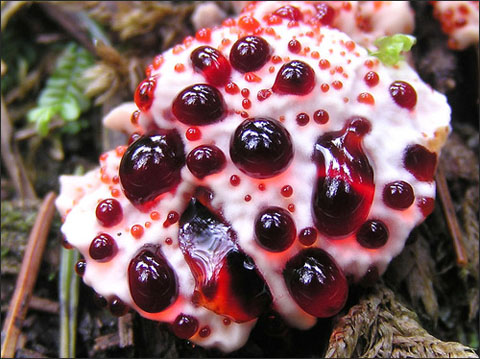
For its amazing appearance, this fungus has received a lot of names - strawberries with cream, tooth juice, bleeding or devil's tooth.
Rafflesia Arnoldi or "corpse lily"
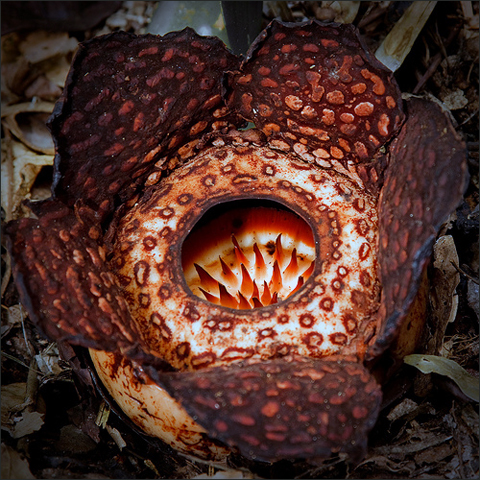
Rafflesia Arnoldi is a huge flower, blood-red in color, consisting of five thick fleshy petals. They are dotted with white growths, appearance resembling warts.
Velvichia is amazing - a tree or a bush?

Welwitschia amazing (Welwitschia mirabilis) is unlike any specimen known to scientists. It grows in the barren deserts of South West Africa, more precisely in the coastal desert of Namibia.
Velvichia is a trunk that looks like a huge stump or stump of a tree, for the most part hidden in the ground, crowned with two leathery immortal leaves. The unusual huge leaves of this plant, reaching up to 6 meters in length, are immortal in the truest sense of the word! After all, they live up to two thousand years - this is the longest life expectancy of Velvichia.
Amorphophallus titanic: flower giant

Amorphophallus titanic lives for about forty years, but blooms only a few times during the entire period of its life. There is a huge tuber of a plant in the ground, the weight of which, in some cases, reaches fifty kilograms. A green stem develops from the tuber, in the upper part of which there is one large leaf and several small ones. And the composition is crowned with an unusual flower of titanic size. Every year, old leaves die off, and new green leaves grow in their place. On the stem of the amorphophallus, female flowers first open, and after a few days male flowers, the flowering period lasts only two days. The temperature of the upper part of the flower is close to the temperature of the human body, thanks to this property, this unusual plant attracts a huge number of insects that pollinate it.
Desmodium rotatus: a dancing plant

Desmodium rotating or telegraph plant, as it is also called, is a shrub that reaches 1.2 meters in height, has oblong leaves resembling an ellipse, and the upper leaves of the plant are slightly drooping and much larger than the side ones. The flowers are small and clustered in racemes.
In strong light, the side leaves of the plant begin to rotate along a strictly defined trajectory. In 30 seconds, the lateral leaves of the desmodium describe a complete ellipse with their tips, their rotation is jerky and slightly resembles a message transmitted by Morse code, which is probably why the desmodium is called a telegraph plant.
Satin (satin wood): chic, shine, beauty!
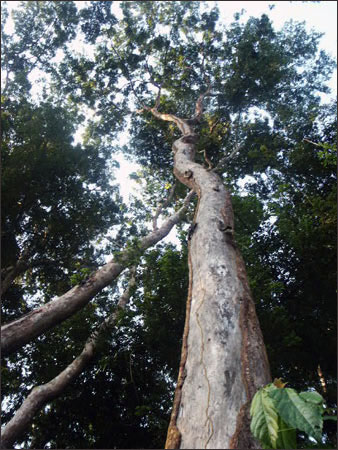
Satin, it is satin wood- a representative of the Rutov family. It grows on the island of Sri Lanka and in southern India, in forests with low air humidity. The tree trunk reaches a height of only 3 meters, and a width of just over 30 cm. It is covered with thin, shiny bark, similar to satin fabric, hence the name of the plant.
Being inquisitive, man has always been interested in various records in the plant world. It is important for him to know which flower and which plant is the largest, which is poisonous, and which is the most unusual.
The biggest flower
Among the flowers there are record holders for growth. The largest single flower is Rafflesia Arnoldi. He is able to grow more than ninety centimeters. Its weight is about eleven kilograms. Rafflesia grows in the rainforests of Sumatra, Indonesia, Borneo, the Philippines and Malaysia.The longest sushi plant is the liana-shaped rattan palm. Its length varies from three hundred to three hundred and fifty meters.

In America, in the Sequoia Park, a huge sequoia grows, bearing the name "General Sherman". The height of the tree is more than eighty-three meters with a trunk diameter of thirty-one meters. Victoria amazonica is another huge tropical herbaceous plant of the Water Lily order. The leaves of this giant water lily reach two meters in diameter.
The most poisonous plants
Not all plants are harmless. Among them are poisonous, which can harm human health. For example, poison ivy, poison oak, and lacquer tree produce a volatile toxin that can cause severe allergies. 
Dictamnus or Ashnets are dangerous plants for humans. The essential oils they contain can cause long-term chemical burns. Photochemical burns can be caused by a plant such as hogweed. If its juice gets on human skin, nothing will happen, but it’s worth getting to this place sunlight how the skin will be affected by a chemical burn.
The berries and rhizomes of the Crow's Eye are highly poisonous. The plant contains a substance that causes convulsions, vomiting, sometimes leading to paralysis of the respiratory systems. Convulsions, coma and paralysis of the respiratory tract can result in poisoning by plants such as dope and henbane.
The Cikuta plant is one of the most poisonous in the world. Its aroma is similar to carrot, and the taste is reminiscent of radish. One hundred grams of its rhizome can kill a cow. It contains cicutoxin, which causes respiratory arrest and convulsions. This is not the whole list of the most poisonous plants on the planet.
unusual grass
Medicinal herbs are called unusual. One such herb is tarragon. Its second name is "Queen of Herbs". It is a very useful crop, used as a medicine, as a spice and as an ornamental plant. Another unusual herb is wormwood, which is also widely used in medicine. It is impossible not to name St. John's wort, eleutherococcus prickly, lemon balm, oregano, sage, etc. 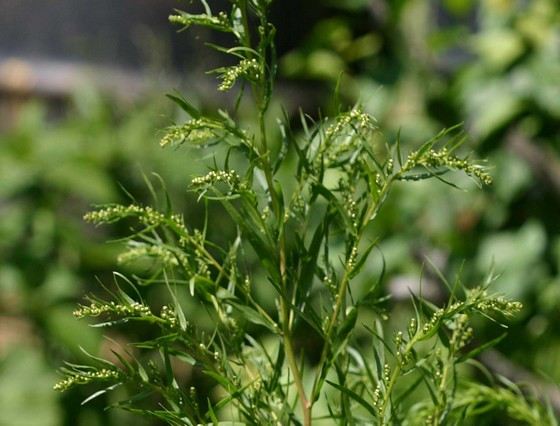
Unusual herbs in appearance are alpine species of colorful living carpets. They grow, forming turf. The most popular carpet plant is the alpine goose. Another very unusual grass growing like a carpet was found on the coast of Lake Chany. It is unusual not only for its red color, but also for the fact that outwardly it is somewhat reminiscent of worms.
Amazing house plants
Pseudolithos looks especially extreme among domestic plants. Its appearance will surprise anyone. Its homeland is Africa and the Arabian Peninsula. The translation of the name is "false stone". The plant looks like a thick egg-shaped tuberous trunk without leaves. The color and shape are similar to stone. Pseudolithos blooms in clusters of bright flowers.An amazing indoor plant that grows without soil is Tillandsia. To grow him up room conditions, you need to acquire a saw cut or bark of a coniferous tree, on which auxiliary roots will be fixed.
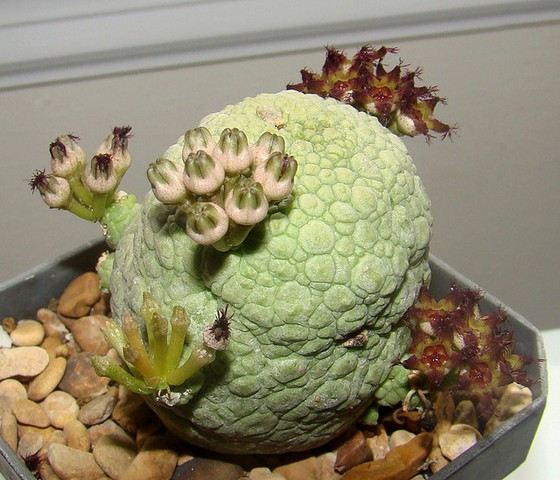
One of the most interesting indoor plants- Lithops. In its shape, the plant resembles a hoof no more than seven centimeters high. It's interesting that most of this plant is underground. Every spring it blooms with large bright flowers.
Bonsai looks original. Its second name is "Tree in a Pot". In fact, Bonsai is a bonsai grown at home. This is just a small list of amazing houseplants.
The most unusual plant in the world
It is difficult to decide which plant is the most unusual, since there are too many amazing representatives of vegetation on the planet. It is quite possible that the most unusual plant is Velvichia amazing. It is able to do without water for about five years, content with moisture from the atmosphere. 
Velvichia lives from four hundred to two thousand years. Externally, the plant looks like two huge leaves, from two to eight meters long. These leaves continue to grow throughout life, gradually tearing longitudinally into ribbons, while the tips dry out. The plant grows in areas of Namibia where the humidity is high due to frequent fogs.
